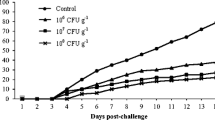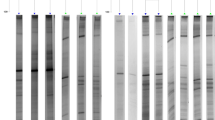Abstract
This study aimed to evaluate the growth performance and intestinal microbiota composition in Pacific white shrimp after probiotic, honey prebiotic, or synbiotic treatment. Pacific white shrimp were treated for 45 days with probiotic (1% (v/w) of Bacillus sp. NP5 RfR probiotic), prebiotic (0.5% (v/w) of honey prebiotic), synbiotic (1% (v/w) of probiotic and 0.5% (v/w) prebiotic), or control (without addition of probiotic and prebiotic). Next-generation sequencing (NGS) was used to assess the effects of these treatments on growth performance and intestinal microbial diversity. The administration of a probiotic, prebiotic, or synbiotic led to increases in specific growth rate, feed conversion ratio, and digestive enzyme activities of amylase, protease, and lipase in Pacific white shrimp. The prebiotic treatment demonstrated the greatest effect, with values of growth rate of 3.09 ± 0.02 (% day−1), feed conversion ratio of 1.45 ± 0.00, and enzyme activities of 1.388 ± 0.0211 IU mg−1 protein for amylase, 0.055 ± 0.0004 IU mg−1 protein for protease, and 0.152 ± 0.0025 IU mg−1 protein for lipase. Analysis of the intestinal microbiota diversity revealed that prebiotic administration caused dominance of the phylum Bacteroidetes, whereas the probiotic and synbiotic treatments caused dominance of the phylum Proteobacteria. Moreover, prebiotic treatment was able to increase the diversity of Microbacterium, Lactobacillus, and Neptunomonas, which are established probiotic candidates in aquaculture. The probiotic, prebiotic, and synbiotic treatments induced a number of operational taxonomic units (OTUs) significantly higher than control treatment, that is, 470, 480, 451, and 344 OTU, respectively.





Similar content being viewed by others
References
Anguiano M, Pohlenz C, Buentello A, Gatlin DM (2013) The effects of prebiotics on the digestive enzymes and gut histomorphology of red drum (Sciaenops ocellatus) and hybrid striped bass (Moronechrysops x M. saxatilis). Br J Nutr 109(4):623–629
Bergmeyer HU, Grossi M, Walter HE (1983) Samples, reagents, assessment of results. In: Bergmeyer HU (ed) Methods of enzymatic analysis, vol 2, 3rd edn. Academic Press, Michigan, pp 274–275
Blandford MI, Taylor-Brown A, Schlacher TA, Nowak B, Polkinghorne A (2018) Epitheliocystis in fish: An emerging aquaculture disease with a global impact. Transbound Emerg Dis 65:1436–1446
Borlongan IG (1990) Studies on the lipases of milkfish (Chanos chanos). Aquacult 89:315–325
[FAO] Food and Agriculture Organization of the United Nations (2019) Globefish highlights a quarterly update on world seafood markets 2nd issue 2019. https://www.fao.org/3/ca5307en/ca5307en.pdf. Accessed 24 July 2019
Fakruddin Md, Chowdhury A (2012) Pyrosequencing an alternative to traditional Sanger sequencing. Am J Biochem Biotechnol 8(1):14–20
Fan L, Li QX (2019) Characteristics of intestinal microbiota in the Pacific white shrimp Litopenaeus vannamei differing growth performances in the marine cultured environment. Aquaculture. https://doi.org/10.1016/j.aquaculture.2019.02.075
Fjellheim AJ, Klinkenberg G, Skjermo J, Aasen IM, Vadstein O (2010) Selection of candidate probiotics by two different screening strategies from Atlantic cod (Gadus morhua L.) larvae. Vet Microbiol 144:153–159
Fuandila NN, Widanarni W, Yuhana M (2019) Growth performance and immune response of honey prebiotic fed Pacific white shrimp Litopenaeus vannamei to Vibrio parahaemolyticus infection. J Appl Aquac. https://doi.org/10.1080/10454438.2019.1615593
Ghanbari M, Kneifel W, Doming KJ (2015) A new view of the fish gut microbiome: advances from next-generation sequencing. Aquaculture 448:464–475
Gilliland MG, Young VB, Huffnagle GB (2012) Chapter 40-Gastrointestinal microbial ecology with perspectives on health and disease. In: Johnson LR, Ghishan FK, Kaunitz JD, Merchant JL, Said HM, Wood JD (eds) Physiology of the gastrointestinal tract, 5th edn. Elsevier, Boston, pp 1119–1134
Hamsah H, Widanarni W, Alimuddin A, Yuhana M, Junior MZ, Hidayatullah D (2019) Immune response and resistance of Pacific white shrimp larvae administered probiotic, prebiotic, and synbiotic through the bio-encapsulation of Artemia sp. Aquacult Int. https://doi.org/10.1007/s10499-019-00346-w
Hu X, Yang H-L, Yan Y-Y, Zhang C-X, Ye J-d, Lu K-L, Hu L-H, Zhang J-J, Ruan L, Sun Y-Z (2018) Effects of fructooligosaccharide on growth, immunity and intestinal microbiota of shrimp (Litopenaeus vannamei) fed diets with fish meal partially replaced by soybean meal. Aquacult Nutr 25:194–204
Huynh T-G, Shiu Y-L, Nguyen T-P, Truong Q-P, Chen J-C, Liu C-H (2017) Current applications, selection, and possible mechanisms of actions of synbiotics in improving the growth and health status in aquaculture: a review. Fish Shellfish Immunol 64:367–382
Jaramillo-Torres A, Rawling MD, Rodiles A, Mikalsen HE, Johansen L-H, Tinsley J, Forberg T, Aasum E, Castex M, Merrifield DL (2019) Influence of dietary supplementation of probiotic Pediococcus acidilactici MA18/5M during the transition from freshwater to seawater on intestinal health and microbiota of atlantic salmon (Salmo salar L.). Front Microbiol. https://doi.org/10.3389/fmicb.2019.02243
Kesarcodi-Watson A, Kaspar H, Lategan MJ, Gibson L (2012) Alteromonas macleodii 0444 and Neptunomonas sp. 0536, two novel probiotics for hatchery-reared Greenshell™ mussel larvae, Perna canaliculus. Aquacult 309: 49–55
Kesarcodi-Watson A, Miner P, Nicolas J-L, Robert R (2012) Protective effect of four potential probiotics against pathogen-challenge of the larvae of three bivalves: Pacific oyster (Crassostrea gigas), flat oyster (Ostrea edulis) and scallop (Pecten maximus). Aquaculture 344–349:29–34
Kewcharoen W, Srisapoome P (2019) Probiotic effects of Bacillus spp. from pacific white shrimp (Litopenaeus vannamei) on water quality and shrimp growth, immune responses, and resistance to Vibrio parahaemolyticus (AHPND strains). Fish Shellfish Immunol 94:175–189
Kongnum K, Hongpattarakere T (2012) Effect of Lactobacillus plantarum isolated from digestive tract of wild shrimp on growth and survival of white shrimp (Litopenaeus vannamei) challenged with Vibrio harveyi. Fish Shellfish Immunol 32:170–177
Li B, Zhang X, Guo F, Wu W, Zhang T (2013) Characterization of tetracycline resistant bacterial community in saline activated sludge using batch stress incubation with high-throughput sequencing analysis. Water Res 47:4207–4216
Li J, Tan B, Mai K (2009) Dietary probiotic Bacillus OJ and isomaltooligosaccharides influence the intestine microbial populations, immune responses and resistance to white spot syndrome virus in shrimp (Litopenaeus vannamei). Aquacultute 291:35–40
Liu Y, Xing R, Liu S, Qin Y, Li K, Yu H, Li P (2019) Effects of chitooligosaccharides supplementation with different dosages, molecular weights and degrees of deacetylation on growth performance, innate immunity and hepatopancreas morphology in Pacific white shrimp (Litopenaeus vannamei). Carbohydr Polym. https://doi.org/10.1016/j.carbpol.2019.115254
Madigan MT, Martinko JM, Parker J (2003) Brock biology of microorganisms, 10th edn. Prentice-Hall Inc, Upper Saddle River
Methé BA, Nelson KE, Pop M, Creasy HH, Giglio MG, Huttenhower C, Gevers D, Petrosino JF, Abubucker S, Badger JH (2012) A framework for human microbiome research. Nature 486(7402):215–221
Munaeni W, Yuhana M, Widanarni W (2014) Effect of micro-encapsulated synbiotic at different frequencies for luminous vibriosis control in white shrimp (Litopenaeus vannamei). Microbiol Indones 8(2):73–80
Paul BG, Vogl CR (2011) Impacts of shrimp farming in Bangladesh: challenges and alternatives. A review. Ocean Coast Manag 54:201–211
Putra AN, Widanarni W (2015) Screening of amylolytic bacteria as candidates of probiotics in tilapia (Oreochromis sp.). Res J Microbiol 10(1):1–13
Ringo E, Olsen RE, Gifstad TO, Dalmo RA, Amlund H, Hemre G-I, Bakke AM (2010) Prebiotics in aquaculture: a review. Aquacult Nutr 16:117–136
Wang H, Wang C, Tang Y, Sun B, Huang J, Song X (2018) Pseudoalteromonas probiotics as potential biocontrol agents improve the survival of Penaeus vannamei challenged with acute hepatopancreatic necrosis disease (AHPND)-causing Vibrio parahaemolyticus. Aquacult 494:30–36
Wang J, Huang Y, Xu K, Zhang X, Sun H, Fan L, Yan M (2018) White spot syndrome virus (WSSV) infection impacts intestinal microbiota composition and function in Litopenaeus vannamei. Fish Shellfish Immunol 84:130–137
Widanarni W, Yuhana M, Muhammad A (2014) Bacillus NP5 improves growth performance and resistance against infectious myonecrosis virus in white shrimp (Litopenaeus vannamei). Ilmu Kelautan 19(4):211–218
Worthington V (1993) Worthington enzyme manual. Enzymes and related biochemicals. Worthington Biochemical Corporation, Lakewood, p 399
Xia Y, Wang M, Gao F, Lu M, Chen G (2019) Effects of dietary probiotic supplementation on the growth, gut health and disease resistance of juvenile Nile tilapia (Oreochromis niloticus). Anim Nutr. https://doi.org/10.1016/j.aninu.2019.07.002
Xie J-J, Liu Q, Liao S, Fang H-H, Yin P, Xie S-W, Niu J (2019) Effects of dietary mixed probiotics on growth, non-specific immunity, intestinal morphology and microbiota of juvenile Pacific white shrimp, (Litopenaeus vannamei). Fish Shellfish Immunol. https://doi.org/10.1016/j.fsi.2019.04.301
Yang F, Li L, Si Y, Yang M, Guo X, Hou Y, Chen X, Li X (2016) Complete genome sequence of a xanthan-degrading Microbacterium sp. strain XT11 with the potential for xantho-oligosaccharides production. J Biotechnol 222:19–20
Yun L, Yu Z, Li Y, Luo P, Xiao Jiang X, Tian Y, Ding X (2019) Ammonia nitrogen and nitrite removal by a heterotrophic Sphingomonas sp. strain LPN080 and its potential application in aquaculture. Aquaculture 500:477–548
Acknowledgements
The authors are highly thankful to Rector of IPB University, the Fish Health Laboratory in the Department of Aquaculture, FPIK-IPB University and PT. Genetika Science, which has provided research facilities.
Author information
Authors and Affiliations
Contributions
WH, WW, and MY compiled and designed the experiment. All the authors contributed to the interpretation of results and made a significant contribution to the preparation of the manuscript. All the authors have read, revised, and approved the final version of the manuscript.
Corresponding author
Ethics declarations
Conflict of interest
The authors declare that they have no conflict of interest.
Additional information
Publisher's Note
Springer Nature remains neutral with regard to jurisdictional claims in published maps and institutional affiliations.
Rights and permissions
About this article
Cite this article
Hasyimi, W., Widanarni, W. & Yuhana, M. Growth Performance and Intestinal Microbiota Diversity in Pacific White Shrimp Litopenaeus vannamei Fed with a Probiotic Bacterium, Honey Prebiotic, and Synbiotic. Curr Microbiol 77, 2982–2990 (2020). https://doi.org/10.1007/s00284-020-02117-w
Received:
Accepted:
Published:
Issue Date:
DOI: https://doi.org/10.1007/s00284-020-02117-w




